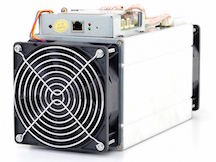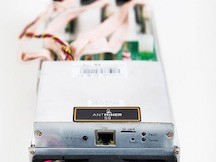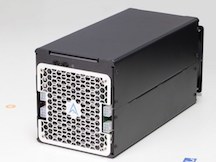Bitmain Antminer S9 Review All You Need to Know
Bitcoin Mining Hardware Comparison
Currently, based on (1) price per hash and (2) electrical efficiency the best Bitcoin miner options are:
PROS
At ~14 TH/s, it has the highest available hashrate
At ~0.1 Joule per GH/s, it is very efficient
CONS
At~$2100 (USD), it is considered expensive
Sold separately, you need to another $170 - $200 for Power Supply
AntMiner S9: Game Changer for Hobbyist Miners?
Since its creation, Bitcoin’s Difficulty has recorded several strong and often consecutive monthly increases , especially from late November 2015. It climbed from 520,569,941 GH/s to the present record high of 1,426,731,353 GH/s, which means Difficulty has nearly tripled since then. This peak was attained on May 24th 2016. That enormous growth has been spurred by major investment into Bitcoin mining technology and operations.
Having that spectacular growth, it has made Bitcoin the world’s most powerful computing network by far, but one unintentional consequence of that rapid growth was increased centralization. There was accumulation of profits, in China, where mining is most profitable that resulted to several contenders (e.g. KNC) being kicked out of the industry.
We have tried to calculate the amount of money that the Chinese have invested in mining; we estimate it to be in the hundreds of millions of dollars. Even with free electricity we cannot see how they will ever get this money back. Either they don’t know what they are doing, but that is not very likely at this scale or they have some secret advantage that we don’t know about.
- Sam Cole, KNC CEO
The same Chinese competitive advantage has been even more effective at extracting the profit-dependent hobbyist miner from the market. At this stage, in order to support the network, aid decentralization and possibly even to heat space, most home or office miners aren’t even hashing for the purpose of obtaining money.
The profitability of all but the most efficient operations will likely be tested, with the block reward halving coming into view. Will the new S9 be a game changer for smaller and hobby miners and return their lost profitability given that profits derived from the current generation of mining hardware are decreasing and will likely reach negative returns after halving?
The S9’s 16 Nanometer Technological Advantage
Even if the process cannot continue forever with the current technology, the on-going miniaturization of semiconductors allows ever greater computing power and electrical efficiency. Many have declared that Moore’s law is no longer true, because the rate of computing speed advancement has slowed as it reaches the physical limitations of silicon semiconductor technology.
A vital enhancement upon the 28 nm design usual to other modern mining devices is the 16 nm fabrication process used in the manufacture of the S9. Even though a 10nm process is just around the corner for 2017, further increases beyond that remain theoretical. Also, the design and manufacture of any 10nm Bitcoin mining hardware is likely to take at least a year.
Power Supply
The great news is that existing power supplies, at least those of sufficient wattage, are fully compatible with the S9.
Recommended for use with the S9 are:
1. AntMiner APW-12 1600 Watt Bitcoin Miner PSU, which is sold for just under $200 on Amazon, and
2. The EVGA SuperNOVA 1300 Watt GPU PSU, which is also priced for about $170 still on Amazon. Be reminded that the 1600 Watt EVGA PSU is significantly more costly, by about $115, compared to Ant Miner’s equivalently-powered offering.
Bitcoins / Month (Profitability)
Compared to any previous device crammed into its silicon, the S9 has more hashing power which is a massive 14 TH/s (TeraHash per second). We combined a total of 189 chips, spread over 3 circuit boards to achieve this phenomenal hashrate. Not to include the 15 brief TH/s spike that happened late 2011, a single S9 unit boasts a hashrate equivalent to the peak capacity of the entire Bitcoin network from its bootstrapping until mid-2012!
Let’s compute the projected profits from all that hashpower via CoinWarz’ Bitcoin mining calculator:
Bear in mind that Power Cost will be depending to your location and that Difficulty differs every two weeks, usually to the upside. Always remember that during post-halving, a number of marginal miners will most likely be pushed to either upgrade to a better hardware or shut down.
Your mining pool will decide your Pool fees; when solo-mining, a single unit is highly unlikely to find any blocks although the S9 is highly powerful. Finally, the Bitcoin to Dollar (USD) price is notorious for its constant continuous change.
As per the inputs discussed above, the S9 will yield 0.285 BTC / $159 per month and 3.36 BTC / $1939 in a year.
These puts return on Investment (ROI) slightly above one year! Of course, supposing that all factors were to stay constant for such impressive result despite the fact that it is very unlikely in the constant-changing world of Bitcoin!
Power Consumption
What makes the S9 the most electrically-efficient mining device to date is the cutting-edge manufacturing process. It uses a mere 0.1 Joules per Gigahash, making it roughly 2.5 times more efficient than the Antminer S7. The total power consumption of the device works out to around 1350 watts, although this figure is subject to about 7% of variance. The S9 consumes about 300W more than the S7.
Price
Starting from the 12th of June, the earliest batch of S9s will be available for order directly from Bitmain . The S9 is definitely high-priced, amounting to $2100 on Amazon. However, if you have low electricity costs, your odds are better than the miner paying for itself within a reasonable time frame. Ultimately though, a lot of which depends on the Difficulty and Bitcoin price.
As smaller manufacturing processes become standard across the industry and as other manufacturers release competing hardware, the S9’s price can be expected to drop appreciably over the coming months. Sometime in winter 2016, Bi Wang is launching its 14nm chips and BitFury’s own 16nm architecture hardware, promising fantastic power efficiency at 0.06 J/GH, is also reported to be coming soon.
Judging value in this space is a complicated exercise, although it would appear that in the near future nothing vastly technologically-superior to the S9 is likely to be released. The release cycle of a new generation of mining hardware every few months is likely to decrease from this point on, as manufacturers have transitioned to cutting-edge 16 and 14nm designs.
Setup
The S9 is a self-contained unit, excluding the power supply. No connection is needed to another computer to interface with other Bitcoin nodes. Its onboard web management portal allows for a simplified setup and maintenance process.
Temperature
The S9 is air-cooled and due to its sturdy design, it is fairly easy to maintain and service. As long as it is in a place with great ventilation, the S9 performs reliably, whether only one or several unit(s) is kept in a spare room or hundreds to thousands of units in a huge mining center.
Verdict: Does Hobby Mining with an S9 make Business Sense?
Yes, according to the data and results calculated above.
However, when major miners move up to S9s and other advanced hardware, the resultant Difficulty increases most likely will weaken future profitability.
On the contrary, profitability will increase due to halving that could bring about a higher Bitcoin price and reduced competition.
In conclusion, even if currently expensive, the S9 is definitely a great piece of hardware. Although ROI cannot be given an assurance, with the natural unpredictability of Bitcoin mining, it is likely to remain profitable for a longer period of time than the preceding generations of ASIC miner.



